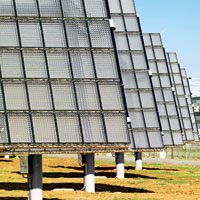As young and developing as the solar photovoltaics industry is today, concentrating photovoltaics (CPV) finds itself in an even more nascent stage, fighting for visibility and funding in a burgeoning solar market. The CPV industry is about where the thin-film PV industry was seven or eight years ago, struggling for bankability, according to Nancy Hartsoch, director of the CPV Consortium.
Aaron Hand, Editor-in-Chief -- Semiconductor International, 12/1/2009
As young and developing as the solar photovoltaics industry is today, concentrating photovoltaics (CPV) finds itself in an even more nascent stage, fighting for visibility and funding in a burgeoning solar market. The CPV industry is about where the thin-film PV industry was seven or eight years ago, struggling for bankability, according to Nancy Hartsoch, director of the CPV Consortium (Sunnyvale, Calif.).
There is a long list of CPV companies in the solar industry — close to 40 in all — but only a few of them are likely to survive, said Eric Wesoff, senior analyst for Greentech Media. "That's not cynical," he said. "That's just venture capital odds."
Wesoff moderated a CPV-focused session at Solar Power International in October, where various sector executives gave their views on the technology and its place in the solar energy market. A key question about CPV and other solar companies is how they are likely to survive and prosper in this market, Wesoff said.
According to Joe Budano, CEO at Energy Innovations Inc. (EI, Pasadena, Calif.), which competes in the CPV space with its Sunflower highly concentrated PV (HCPV) system, CPV's time is nigh. "CPV has grown up and is ready to go off to college," he said during the Solar Power session.
Combining a very small and very high-efficiency PV cell with collector optics, CPV competes with concentrating solar thermal (CST) on the one hand and silicon and thin-film PV on the other. Where CPV technology shines is in geographical areas with high direct normal irradiance (DNI) — the sunlight that shines directly on a given area. Though the more sun the better may seem intuitive for solar energy systems, other PV technologies, particularly the market-dominating crystalline silicon (c-Si) technologies, do not stand up well to excessive heat. Although less so, even thin-film PV's performance is adversely affected by its temperature coefficient.
 |
|
Concentrix Solar has installed CPV systems throughout Spain, including these systems in Puertollano. |
CPV, on the other hand, performs best at higher temperatures. It depends on large amounts of direct sunlight for its efficiencies, making it well suited to utility-scale installations in open areas with little cloud cover. Ideally, CPV needs geographical areas with a DNI of ≥6, such as Spain, southwestern United States, or Australia (parts of Chile have a DNI of >9).
CPV is a relatively broad category, with companies approaching the PV/optics combo in a variety of ways. EI's high-concentration route (1200:1), for example, has reached a module efficiency of 29%. It combines silicone on glass (SOG) Fresnel lenses with high-efficiency triple-junction cells (>38% efficiency).
SolFocus Inc. (Mountain View, Calif.), as another example, makes CPV systems with a concentration of 500:1, combining the same triple-junction cells with reflective optics to achieve >25% efficiency.
Concentrix Solar GmbH (Freiburg, Germany), a spin-off of Fraunhofer Institute for Solar Energy Systems (IES, Freiburg), also uses Fresnel lenses in its technology, achieving DC module efficiencies of 27% to date. These are very exciting times for CPV companies, according to CEO Hansjörg Lerchenmüller, with some companies ready to deploy systems. "On the other hand, the market is being really difficult," he said. "Will CPV really make it?"
But CPV will be the preferred solution for electricity generation in sunbelt areas, he said, because it's so easy to deploy. "These products are ready today," said Mark Crowley, president and CEO at SolFocus. "They're out in the field in Spain." SolFocus has had systems in the field for almost three years, in multiple locations, he said, including Hawaii, California and Arizona. "We think we're commercially ready."
Concentrix, Lerchenmüller noted, has installed several power plants in the field, mostly in Spain. The most important factor in CPV's success will be production cost, he said. He's convinced that CPV will become the cheapest PV technology because of its simplicity.
SolFocus's Crowley agreed, saying that CPV has the fastest cost reduction path in the industry, and will be able to maximize the energy returned per cents per kilowatt hours. "You're not going to get a whole lot more out of the silicon systems," he said.
"There's a perception that CPV is too expensive," said the CPV Consortium's Hartsoch, who is also vice president of marketing for SolFocus. But there are a lot more ways to drive costs down, she said, noting that the industry could move much faster if it did more non-proprietary work.
That is a key goal of the CPV Consortium, which began in mid-2007 to help support the sector's infrastructure. CPV manufacturers will give up some conversion efficiency to get manufacturability, and that is a direction that the cell suppliers will need to focus on more going forward as well, providing more manufacturable solutions. "We need cell guys who think like commercial companies, not aerospace companies," said Hartsoch.











